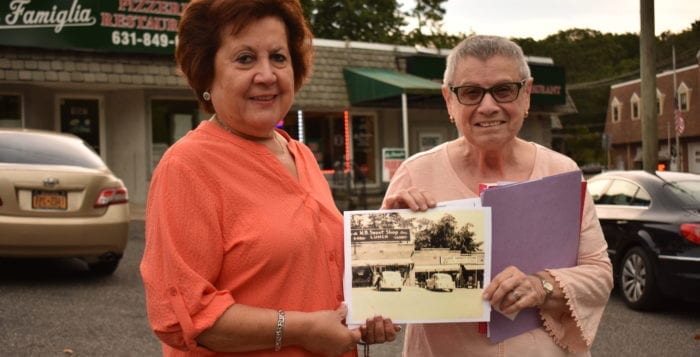Sound Beach community sees through the looking glass of history

Ninety years ago in 1929, New York City newspaper The Daily Mirror offered subscribers the opportunity to buy a 20- by 100-foot parcel of undeveloped land between Rocky Point and Miller Place. The cost to purchase a plot of land through the subscription was $89.50 in 1929, equivalent to $1,315 in 2019.
In the trees and rocks of Long Island’s North Shore, a hamlet slowly rose from the earth.
Sound Beach is a hamlet of only 1.6 square miles and around 7,612 people, according to the last census. Stuffed in between Rocky Point and Miller Place, one of the North Shore’s smallest hamlets barely scrapes along the ubiquitously driven Route 25A. For those who don’t know the area, the hamlet boundaries are often mistaken for that of its neighbors.
Rocky Point has a historical society. So does Miller Place, combined with bordering Mount Sinai. Now prominent members of the Sound Beach community feel that’s something that needs correcting.

Mimi Hodges, a near lifelong resident, is just one of the several women who are looking at Sound Beach’s past. She said that ad in the newspaper didn’t attract your average vacationers looking to take a break from New York City. They were working-class individuals, all of whom were looking for a change of pace during the depression era of the 1930s. They came with very little, sometimes only tents for their families, but still managed to build a small but safe town.
“Sound Beach is unique in that it was a place created specifically for the working class,” she said. “People who didn’t have a lot of money and wanted to get away from the city — from Brooklyn and Queens. They put up their tents, they put up their own little houses, and eventually, in 1930, the Sound Beach Property Owner’s Association was born.”
The Sound Beach history project, which is being spearheaded by the Sound Beach Civic Association, is hoping to bridge that gap. Engineered by community leaders and longtime residents, local women are already uncovering several old photographs that show a much different Sound Beach, full of dirt roads and dusty buildings.
“It’s like a little mystery,” said Sound Beach Civic Association President Bea Ruberto.
Vilma Rodriguez, another resident, said work comes in bits and pieces, but their group has been energized.
“Sound Beach had no roads, no streetlights,” she said referring to the olden days of the small hamlet. “It’s little bits of information, but it builds up.”
For many of its earliest decades, mail was sent and received through Scotty’s General Store on Echo Avenue or Moeller’s General Store on Sound Beach Boulevard. It wasn’t until June 1, 1946, the first post office opened in the hamlet.
In the small shopping center off of New York Avenue, where La Famiglia Pizzeria currently resides, the locals used to go to M.B. Sweet Shop for lunch and candy. Next to it, instead of the Italian restaurant, was the Square Market Store. Local resident Florence McArdle attributed the local setting to a particular show.
“It was just like ‘Happy Days,’” she said.
Back in the day, the building that now houses Bedrossian Real Estate on Northport Road once was a community house that hosted everything from dances to pingpong and knock hockey. In that time, lacking a church, McArdle, a resident from the 1930s, said local community members “would iron the tablecloth, flip it over and they would have Mass on Sundays in the bar, Boyles.”
Sound Beach once had its own police department, its own highway and sanitation department. People once gathered at the “pavilion” on the bluff, where kids could buy ice cream and hot dogs.
Local resident Stephanie Mcllvaine said she has been pouring through newsletters from the 1940s, which reveal just how much has changed in the 80 years since. She wrote that a May 1940 newsletter was the census results. John Mertz, the winter caretaker and “mayor,” found 61 families consisting of 185 people lived in Sound Beach year-round. There were four general stores, three gas stations, one restaurant, five general contractors, two masons, one electrician, two fire wardens and two deputy sheriffs. Many of the year-round residents were members of the fire department as well.
Despite their deep dive into this local history, many things are still unknown. What locals call “The Square” was either called Journal Square or Moeller Square, though Ruberto did not know where Journal Square even came from. There was a Moeller of the general store fame, but she has had trouble getting in contact with the family. She learned there was a James Moeller who taught math at the Miller Place School District but learned from the board of education he passed in 2012.
Barbara Russell, the Town of Brookhaven historian, said her office has only a few items and details in the way of Sound Beach, but she praised the women for taking on the task. She said with the enthusiasm the group is showing, they’re well on their way to creating walking tours or a historical society.
Many of the local women looking back at the hamlet’s history have a fondness for the way things were. They watched the area grow slowly, ever so slowly, from the working-class family’s retreat to what it is today. Back then, Sound Beach was the destination, and there was no need to drive out and plan visits to other parts of the island, they said.
“Most of us here, we thought we were growing up in a ‘garden of Eden,’” said Hodges. “It was just fantastic.”
For those looking to get involved in the history project or who are interested in donating old photos, contact Bea Ruberto at [email protected] or call 631-744-6952.






